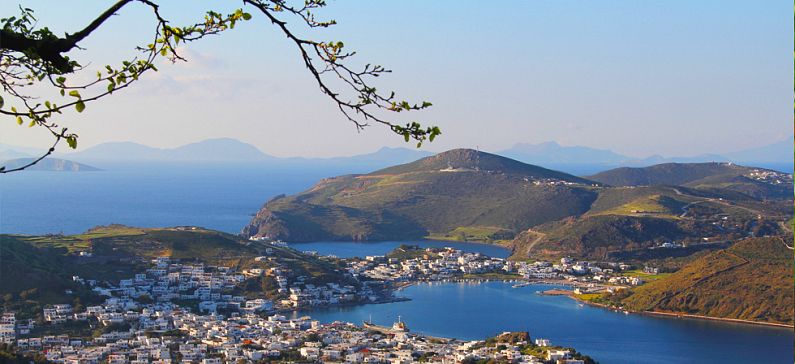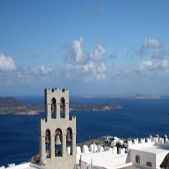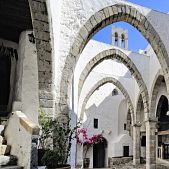
The island of Apocalypse
Patmos with Astypalaia and Leros are in the province of Kalymnos. It is a religious center of universal interest, thanks to the Cave of the Apocalypse and the Monastery of Patmos, while offering an ideal destination for those seeking a holiday that combines relaxation and a beautiful natural environment.
It is a volcanic island, rocky and arid with sparse vegetation. Few trees are mainly found in the aisles of settlements from newer plantations. Chora, the capital of the municipality of Patmos is built on a hill, where the Monastery of St. John the Divine excels in the form of a large castle. Other smaller settlements (villages) of the island is Skala, Campos, Dhiakofti and Stavros.
The island offers to visitors beautiful beaches and clear waters. The easily accessible beach of Skala, the beach Campos and the beach Psili Ammos, which is considered the most beautiful beach of the island, are among those that you should definitely include in your plans. One of the quietest beaches is beach Geranos with trees that provide shadow and a small island with a church opposite to create an idyllic setting.
The volcanic region «Zouloufi» is located on the northwestern side of Patmos. The tuff alternate with lava which flowed and froze from the sea, creates a very impressive landscape.
The Cave of the Apocalypse
The Cave of the Apocalypse is in the middle of the route from the port of Scala to Chora. The Christian tradition states that in the cave the rock was torn and from the three smaller cracks that symbolize the Holy Trinity, the voice of God was heard and dictated the text of Revelation to John.
The cave was transformed to a place of prayer by the founder of the monastery of Patmos St. Christodoulos. Nowadays, pilgrims can see the place that the Revelation was written, the location of the reclining John, the massive rock that was torn and where God dictated the Revelation to John, the point at which the Evangelist lay his head to rest and a cavity in the rock, which he would hold onto to get up. For pilgrimage purposes the southern part of the cave has been turned into a small church.
Monastery of St. John
The ancient inhabitants of Patmos and Leros has as a patron goddess Artemis and they were completely obscure. Until Roman times the island was a place of exile for political prisoners and that character remained until early Christian times, where the student of Jesus, John was exiled. During that time in Patmos John wrote the Revelation and the «Gospel», the sacred books of the Christians in the New Testament.
Hosios Christodoulos, a Bithynian abbot who had already founded monasteries on Léros and Kos, obtained permission from the Byzantine Emperor Alexis I Comnenus to found a monastery on the island dedicated to St John. This was at a time when the imperial state was encouraging resettlement on the islands and shores of the Aegean, a policy that included the establishment of fortified monasteries. The monastery was built on the hill above the cave of the Apocalypse, exactly on the ancient altar of the goddess Artemis. In addition, in the Monastery, which was built in the form of a medieval castle, operates a School from which came most of the Nation teachers, scholars and famous Bishops and Patriarchs.
In the monastery, there is a temple of unique art made in 1820, by 12 sculptors. Icons and frescoes are of unsurpassed beauty and value. Another great chapter of the monastery is its Library. The Library is connected to the history of both the monastery and the entire island and has many rare and extremely valuable books. Among the precious collection of the library, one can find the founding «chrissovoulo» of 1088, where Alexios A” Comnenos ceded Patmos to St. Christodoulos. The Library is a rich source of information for the monastic life and the conditions posed by the current occupiers.
The Monastery of the Apocalypse is the first monastery of the entire world, digitally «mapped» by technicians from Google, making it possible for anyone, anywhere in the world to make the tour of the Monastery. Equally interesting is the fact that visitors to the Google Art Project can see places that are not accessible to visitors such as the library of the monastery, one of the most important worldwide.
TIPS...
-The small island of Pátmos in the Dodecanese is reputed to be where St John the Theologian wrote both his Gospel and the Apocalypse. A monastery dedicated to the ‘beloved disciple’ was founded there in the late 10th century and it has been a place of pilgrimage and Greek Orthodox learning ever since. The fine monastic complex dominates the island. The old settlement of Chorá, associated with it, contains many religious and secular buildings.
-In 1999 the Monastery of Saint-John the Theologian and the Cave of the Apocalypse were declared a World Heritage Site by UNESCO.


















Lawrence G. Immel
-01/09/2017 4:42 am
Awesome Pics pictures & Background Information! Especially John’s Exile! Where He Penned”Revelation”!